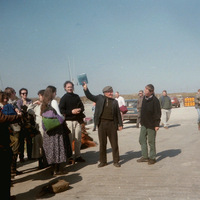 Aran book launch, Kilronan pier, April 1994
Aran book launch, Kilronan pier, April 1994 The central figure in this photo is Dara Beag Ó Fatharta, a native of Baile na Creige on Inis Meáin. A familiar sight to visitors to Dún Chonchubhair and much appreciated by them, he was 'always dressed in the traditional homespun trousers, aran jumper, waistcoat, tweed cap and crios' (Jackie Uí Chionna). Also pictured here are, among others: Jeff O'Connell (left, brown jacket), Pacella Uí Chonaola (right of Jeff), Dara Ó Conaola (left of centre, dark sweater), Anne Korff (right of centre, green trousers), Breandán Ó Madagáin (right, background, white beard),
This is one of 31 photos taken by Frank Imbusch at the launch of The Book of Aran on Inis Mór, Aran Islands, in 1994. Like many other book launches held in different parts of the country, this was a celebration of how the University's research contributes to local and regional life, and also underlines the importance of promotional events and social interactions off the main campus. It was attended by many islanders and mainlanders, including a considerable number of NUIG staff, most of whom travelled by bus to Rossaveal and by boat from there to Kilronan. In 1994, Gordon D'Arcy, one of the contributors to the book, described the experience of bringing the first copies of the book across Galway Bay to the islanders ('Aran Delivery').
Among others present at the launch that day were Frank and Mary Imbusch, Michael D. and Sabina Higgins, Proinsias de Rossa, John de Courcy Ireland, Joe O'Halloran, Seosamh Ó Cuaig, Paul Walsh, Paddy Keady (Pádraig Ó Céidigh), and the book's editors, John Waddell, Anne Korff and Jeff O'Connell.
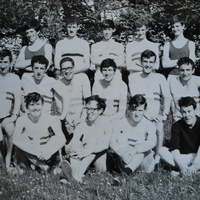 UCG Men's Athletics Team, 1968
UCG Men's Athletics Team, 1968 In 1968 the University's Athletics team took part in the inter-university competition, as they had done since it was first held in 1873. Some of the team seen here were not wearing the UCG Athletic strip because of a shortage of singlets.
Pictured, from left to right:
Back row: D. Geraghty, J. Sheil, P. O'Callaghan, M. Conlon, K. Naughton, [?] , Fr Tom Kyne.
Middle row: C. Cunnane, B. Geraghty, L. Ó Murchú, J. Scanlon, M. Coleman, V. McNicholas.
Front row: [?], N. Matthews, H. Rowan, [?], [?].
The first intervarsity athletics competition was held in 1873, on the Mardyke in the Cork Cricket grounds. 'This was not only the first intercollegiate athletics meeting held in Ireland, but also the world’s first national intervarsity athletics meeting' (Athletics Ireland), as distinct from an athletics competition between two universities, inaugurated by Cambridge and Oxford in 1864.
In 1968, the year of this photo, UCG had 4 athletics successes, all of them in women's events. Fionnuala Lysaght won the Women's 100m in a time of 15.5 seconds, and the 400m in 64.6 seconds; in the Cross-Country Women's Individual competition Marion Keating came first and the Women's Team won the team competition.
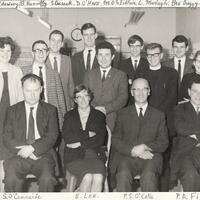 Chemistry Department, UCG, September 1965
Chemistry Department, UCG, September 1965 This photograph of the staff of the Chemistry Department was provided by Professor Elizabeth E. Lee, affectionately known as 'Nellie', who died 18 April 2018. She was the daughter of Myles and Penelope Lee, Mainguard Street, Galway, 'a family renowned for its intellectual capacity and musical talent' (Eileen Scanlon). Among Nellie Lee's interests outside her career in Chemistry was her passion for camogie. Having been a noted player, in 1965 she became President of the UCG Camogie Club and her support for the sport was warmly appreciated by generations of students.
People pictured here, from left to right:
Standing: M. Muldowney, B. Hanniffy, S. Cusack, D. O'Hare, Micheál Ó hEidhin, L. Murtagh, Bro. Creggy, H. Lawless,
Seated: Seán Ó Cinnéide, E. Lee, P.S. Ó Colla, P.A. Finan.
 Archaeology field trip, 1946
Archaeology field trip, 1946 Members of the Archaeological Society 1946.
Back row: Unidentified; Unidentified; Patrick McSweeney; Eamon Joyce; Noel Keane.
Middle row: Ms Gillespie; Aideen Timoney; Pete McCaffrey; Unidentified; Mrs Molloy (née O'Malley); Unidentified.
Front row: Tadhg O'Sullivan; Ms Coyle; Carmel Kelly; Dr Colm Ó hEocha (later President); Cecily McNally (reclining); Daiden Fahy (with headscarf); Unidentified; Unidentified.
Colm Ó hEocha and Daiden were married some 10 years after this photograph was taken and Colm was appointed Professor of Biochemistry in 1963. He was President of the University from 1975 to 1996.
Archaeology Society outings attracted students taking Archaeology as a subject for their degree and other people who were simply interested in the general area. The impetus for these excursion from the late 1940s on came from Michael Duignan who was appointed to the Chair of Celtic Archaeology in 1945.
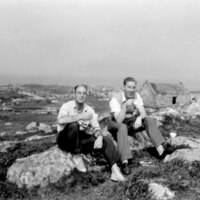 Relaxing at Mace Head, Carna, 1958
Relaxing at Mace Head, Carna, 1958 At the time this photo was taken, Frank Gaffney (left) and Tom O'Connor (right), of the Physics Department, were engaged in measuring atmosphere composition on the edge of the North Atlantic.
Frank Imbusch records that:
'Tom O’Connor joined the staff of the UCG Physics Department in 1956 with a MSc degree from UCD and having spent a period in Atmospheric Physics research at the Dublin Institute for Advanced Studies. With the assistance of Frank Gaffney, the Department’s technician, Tom set up a research facility to continue this research in UCG. In addition, a small weather station collecting daily weather reports was set up on campus, and Frank Gaffney collected and recorded the data.
As Tom recalled in a 1999 article in 'From Queen’s College to National University' :
“In the summer of 1957 I cycled around the coast of Connemra looking for a site for a research station which would receive air from the Atlantic Ocean which had not crossed over local sources of contamination such as roads or houses. An excellent site was located at Mace Head on the Ard peninsula west of Carna looking oit at the uninhabited Mac Dara’s Island and across the mouth of Bertraghboy Bay towards Roundstone to the northwest. Winds from the sector180 degrees N to 300 degrees N reach the site without passing over local sources of man-made pollution. A disused World War 11 coastal lookout post was leased and renovated, electricity was installed, and measurements of ionization equilibrium in maritime air began there in 1958. This work was strengthened and expanded when I was awarded the first research contract between University College Galway and an Office of the US Forces in Europe on the origin of very small particles or condensation nuclei in the atmosphere as a result of photochemical reactions of trace gases from natural sources” (T. OConnor, p. 208).
Much work had to be done on the “excellent site” mentioned by Tom. He and Frank Gaffney cleared the site, which involved moving stones and boulders to improve accessibility to the station. Electricity had to be installed and windows repaired before equipment could be brought in. Eventually, in 1958, research activity began at the Mace Head Atmospheric Research Station.
The present complex is a far cry from the small coastal look-out station that was its first home. In 2008 the Mace Head Atmospheric Research Station celebrated the 50th anniversary of its establishment, and Tom O'Connor and Frank Gaffney were both present. Indeed retirement did not stop him recording the daily weather data in NUIG. He only stopped recording weather readings in 2012.' (Frank Imbusch)
The remarkable growth of the facility, which began as 'a small coastal lookout post adjacent to the present Mace Head station', took place in a series of steps. In 1975, the original site pictured here was augmented by 'the purchase of a larger (3 hectare) site at Mace Head [...] for use as a background baseline research station. The ruins of a cottage on the site were refurbished for use as a laboratory in 1985 and a standard meteorological recording system was installed there. From the beginning it has housed the most sophisticated of sensitive gaseous and aerosol particulate instrumentation.' In 1989-90 the cottage was extended and another laboratory was added on the shoreline. The facility, managed by the Ryan Institute, University of Galway, 'is the globally acknowledged clean background western European station, providing key baseline input for intercomparison with levels elsewhere in Europe.' ('History of Mace Head', 2008)
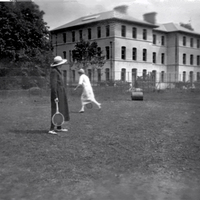 Tennis courts, University of Galway, c. 1920s
Tennis courts, University of Galway, c. 1920s The two tennis players in the photo may be Rita Carlos, mother of Patrick Larkin, and her sister Nina Carlos.
The tennis courts in front of the Engineering Building (now Block E) were later made into a carpark.
The UCG Tennis Club was founded in the 1960s and in 2007 was re-established as a competitive intervarsity team. Instead of the long vanished courts pictured here, the University Tennis Club's members now have access to the Galway Lawn Tennis Club's facilities.
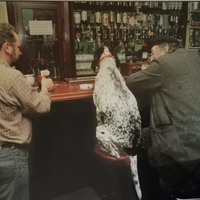 Padraig Ó Céidigh (Paddy Keady) relaxing with his dog
Padraig Ó Céidigh (Paddy Keady) relaxing with his dog Pádraig Ó Céidigh, Professor of Zoology, was generally accompanied by his faithful companion to lectures and other academic events, as well as on social outings such as this one.
The story is often told that when the dog was refused entry to the Library, on the grounds that he had no user card, Paddy Keady returned with him the next day, having somehow registered him as a student and obtained a card. The dog was granted admittance.
 President Reagan and Séamus Keating, 2 June 1984
President Reagan and Séamus Keating, 2 June 1984 President Ronald Reagan, accompanied by First Lady Nancy Reagan, visited NUI Galway on 2 June 1984. There he received an honorary doctorate of laws from the National University of Ireland, presented to him by Dr T.K. Whitaker, Chancellor of the NUI. On the same occasion he was presented with the Freedom of the City and a resolution scroll by Mayor Michael Leahy. On the right in this photograph is Séamus Keating, present in his official capacity as City and County Manager. The scaffolding seen in close-up supported the platform and covering erected for the occasion.
The event was attended by many staff of the University, while others, objecting to President Reagan's policies, either remained away or engaged in protests off-campus.
Both the event on the University campus and the protests in the city drew major media attention. Security on the ground was at a noticeably high level (Galway Advertiser), while significant numbers of aircraft were seen and heard over Galway in the course of the day. In the context of efforts to end violence in the North of Ireland, to which he referred on each day of his visit to Ireland, President Reagan made particular reference to President Colm Ó hEocha's role as chairman of the New Ireland Forum, whose Report had recently been published but 'was being largely ignored internationally, so his [President Reagan's] references to it were deeply appreciated in Government circles' (Dwyer 2014).
The White Houses's official video and transcript of President Reagan's address on the occasion, held in the Ronald Reagan Presidential Library, are available online.
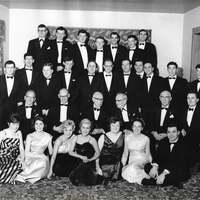 UCG Medical Society Dress Dance, February 1965
UCG Medical Society Dress Dance, February 1965 This, the first UCG Medical Society Dress Dance, was organized by Eoin Ó Dochartaigh. It took place in the Warwick Hotel ('The House that Jack Built'), Salthill, in February 1965. The undergraduates in the photo were all Final Year Medical students.
The Warwick was for many years a centre of social activity including student dances. It was demolished in 2019.
Pictured here, from left to right:
Back row: Des Collins, Gus O’Gorman, Noel Browne, Ger Cloherty, Dick O’Connell, Kieran O’Connor, Bill Curtin.
3rd row: Peadar O’Kelly, Terry Kavanagh, Bart Moloney, Brendan Healy, Myles McEvilly, Eoin Ó Dochartaigh, Tim Sheridan, Charlie Kickham, Luke Clancy, Louis Byrne, Terry Langan, Donal McGoldrick, Karl Fung.
2nd row: Staff members Jimmy Cranny, Dr Jim Doyle, Prof. Stephen Shea, Prof. Neil McDermott, Prof. Bill McHugh, and student John O’Donnell.
Front row: Kieran Tobin, Moya O’Donnell, Anne O’Shaughnessy, Milano twins (Nana and Nina), Doreen Dunleavy, Eithne O’Gorman, Marion Vujevich.
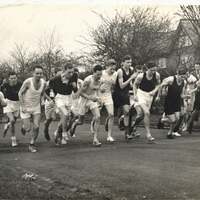 Labhrás Ó Núalláin competing in a cross-country race, Phoenix Park, 1945
Labhrás Ó Núalláin competing in a cross-country race, Phoenix Park, 1945 Among the competitors pictured here is Labhrás Ó Nualláin (3rd from left), who was later appointed Professor of Economics in UCG.
This cross-country race took place in the Phoenix Park in 1945. Seen here are competitors from Edinburgh [?] University and Trinity College Dublin.
After World War 2, this event on 15 December 1945 was the first inter-university cross-country fixture between competitors from Ireland and Britain. It resulted in a win for Trinity over Glasgow University. At the dinner hosted by Trinity College, Professor Pearson of the Medical Faculty proposed a toast to the King, during which Labhrás remained seated.
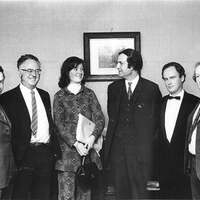 Ballina Chamber of Commerce, 1971
Ballina Chamber of Commerce, 1971 This photograph is remarkable for showing two future Presidents of Ireland early in their careers. Mary Robinson, née Bourke, a native of Ballina, was Ireland's first woman President, elected in 1990 and serving in that office until her resignation in 1997. Michael D. Higgins, originally from Limerick and a graduate and staff member in UCG/NUIG, was elected to the office of President in 2011 and re-elected in 2018.
Seen here, from left: Unidentified; Labhrás Ó Nualláin; Mary Robinson, née Bourke; Unidentified; Unidentified; Michael D. Higgins.
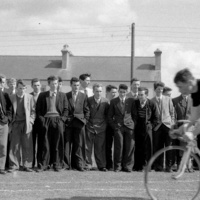 Watching the cycle race, summer 1959
Watching the cycle race, summer 1959 This photograph was taken on Fahy's Field at the 1959 Co. Galway Sports Meet, in which students and staff of UCG participated. It captures the atmosphere of a local sports event in the 1950s. None of the people seen here have been identified.
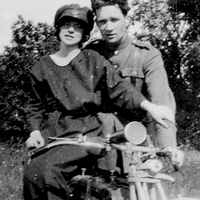 Ed Thornton with Brigid Lyons at UCG
Ed Thornton with Brigid Lyons at UCG Pictured here, from left to right: Brigid or Brighid Lyons, and Edward ('Ed') Thornton. When they married in 1925, Brigid added Thornton to her maiden name, and was thereafter known as Brigid Lyons Thornton.
Born in 1896, Brigid Lyons was from Northyard, near Scramogue, Co. Longford. From 1915 to 1922 she studied medicine in Galway, where she helped to found a branch of Cumann na mBan. In 1916 she participated in the Easter Rising. After a brief period in the Army Medical Service she pursued a long and distinguished career in public health.
'Throughout her life Brigid Thornton fought for the underprivileged, believing strongly that women had an important contribution to make in many occupations traditionally dominated by men. Injustice and deprivation moved her, and she used her energy to fight for the rights of political prisoners, for Belgian refugees, and for the right of women to vote.' (DIB)
Captain Edward ('Ed') Thornton (b. 1899) was from Co. Mayo. The couple met in Nice where both were convalescing from tuberculosis. They returned to Ireland and married in 1925. Edward Thornton passed the Bar and worked as solicitor, wintering in Switzerland. He died suddenly in 1947 and was buried in Toomore Cemetery, near Foxford. When Brigid died in April 1987 she was buried with military honours beside her husband.
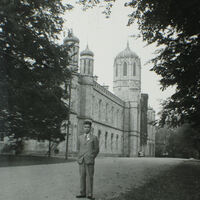 A new student at UCG, 1953
A new student at UCG, 1953 Pictured here is Frank Imbusch as a new student in UCG. The photograph conveys how relatively uncrowded the main campus was in the 1950s. Before the era of Open Days and orientation tours, arriving at University for the first time was a very different experience to the present one.
It was not until 1960 that student numbers passed 1,000 (Cois Coiribe, 2021). By 2023 there were over 18,000. There had been just 68 when the University opened its doors in 1849.
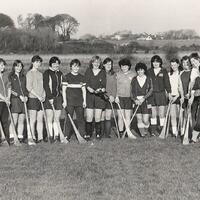 Camogie team, 1982
Camogie team, 1982 In 1982 the UCG camogie team competed as usual for the Ashbourne Cup which was won that year by UCD. When this photo was taken, UCG's most recent success had been in 1979, and they were to regain the Cup in 1989, retaining it in 1990. Between 1916, when UCG first entered the competition, and 2023, the Cup has come to the University of Galway 15 times.
The photo appears to have been taken at a training session or perhaps a local match, as it shows considerable variation in the kit worn by the players. It reflects a relatively recent relaxation of the rules: the appropriate wear for women had been a focus of concern in the GAA early in the history of the game. In 1903, the first set of rules dictated that skirts must be no more than 6 inches from the ground. In the 1970s a blouse worn with a skirt, shorts or a divided skirt became officially acceptable.
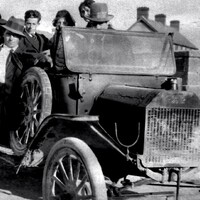 Motorists at Beggars Bridge, 5 June 1921
Motorists at Beggars Bridge, 5 June 1921 The elegantly dressed young man leaning against the car and his companion in the front seat are doing a creditable imitation of Prohibition-era gangsters. None of those present have been identified. The motorcar was still a relatively rare and prized possession in the early 1920s and this photo conveys how students associated it with special outings and social life.
Beggars Bridge is the bridge that crosses the Gaol River, just to the north-west of the Cathedral, on University Road.
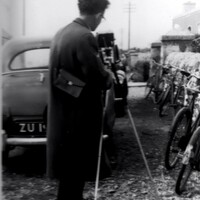 UCG film unit in action, 1960s
UCG film unit in action, 1960s People: Patt Larkin
Patt Larkin, Professor of Education, who initiated the UCG Aonad Scannáin (Film Society) in 1947, was an enthusiastic photographer and amateur film-maker.
The car's number plate indicates that it was registered in Dublin County and County Borough between May 1953 and May 1954.
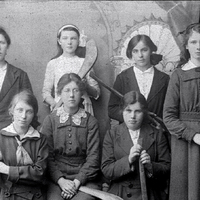 Camogie players, 1921
Camogie players, 1921 Two of the camogie players pictured here have been identified: Margaret M. Carlos, known as Rita (seated, centre) and Mary J. Carlos, known as Nina (standing, left). In 1916 UCG competed for the Ashbourne Cup in the intercollegial camogie tournament which had been established the previous year. It was won by UCG in 1917 and 1920 and a further 13 times between then and 2022.
'Some members of the UCG winning 1917 team refused to have their names engraved on the cup in the Irish language, something that brought their future selection into doubt.' (Wikipedia). There are interesting anecdotes regarding the Ashbourne in later decades (including Siobhán McKenna’s prowess) in Jackie Uí Chionna's Oral History of University College Galway.
The camogie sticks at the time were differently shaped to those used today. It was, and is, usual to inscribe one’s name on the stick or camán. Nina's name is clearly visible on her stick, and ‘A’ can be seen on that of the young woman seated on the left.
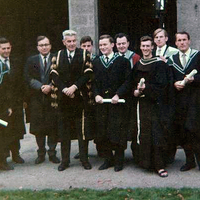 MSc postgraduates with staff, 1965
MSc postgraduates with staff, 1965 Pictured here, from left to right:
Unidentified; Seán Tobin; Jim Flavin; President Martin J. Newell (Máirtín Ó Tnúthail); Unidentified; Ted (Thaddeus C. ) Hurley; Matthew F. McCarthy; Unidentified Franciscan brother; Unidentified; Unidentified.
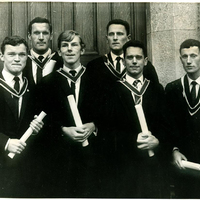 MSc class of 1965
MSc class of 1965 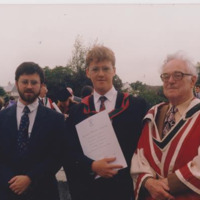 Labhrás Ó Núalláin at Conor Ó Dochartaigh's graduation, 1993
Labhrás Ó Núalláin at Conor Ó Dochartaigh's graduation, 1993 Labhrás Ó Nualláin, who was a lecturer in and subsequently Professor of Economics, is seen here with his two grandsons, Niall and Conor Ó Dochartaigh, at the latter’s graduation. Labhrás was married to Frances Heraghty from Donegal. Their daughter Niamh married Dr Eoin Ó Dochartaigh, and the two young men seen here are their sons.
Niall Ó Dochartaigh is Personal Professor of Political Science and Sociology at the University of Galway. His brother Conor is a medical consultant in Auckland, New Zealand.
From left to right: Eoin Ó Dochartaigh, Conor Ó Dochartaigh and Labhrás Ó Nualláin.
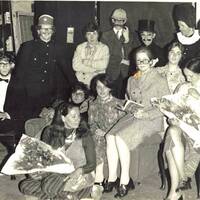 French play in An Taibhdhearc, 1971
French play in An Taibhdhearc, 1971 Two lectrices in the UCG French Department, Claude Mouton and Marie-Paule Péry, and their students put on a French play, Le Bal des voleurs, in An Taibhdhearc on April 25, 1971. Claude was the producer and Marie-Paule directed the play. In 2022, Michael Kane, Claude's husband, wrote an account of the production and some of the students involved. In it he included an extract from a radio interview in which Colm Murray, the well-known broadcaster, reminisced about his role as Gaston, the young male lead. See 'Michael Kane's account of a French play in An Taibhdhearc'.
 Archaeological excavation at Ballaghkeeran, 1982
Archaeological excavation at Ballaghkeeran, 1982 The trial excavation pictured here was conducted by Professor Thomas ('Tom') Fanning of the Archaeology Department, UCG, in 1982. His report gives the following details:
'Co. Westmeath 1982. 184. Ballaghkeeran Little, Athlone (12N 073445). T. Fanning of Department of Archaeology, University College, Galway, excavated a number of trial trenches at a fortified promontory on Lough Ree in the R. Shannon. The possibility that the site was a Viking-type longphort was borne in mind due to the mid 9th- and early l0th-century references to a Viking fortification on the Lough.
Excavation of the earthen bank on the landward side of the promontory showed it to have been of a substantial nature composed of a fine sandy subsoil redeposited on the original ground surface. A charcoal stain close to the inner edge of this bank was sampled for a radiocarbon determination. The cuttings within the promontory exposed two shallow parallel trenches c.10m apart. These features, detected in a magnetometer survey by R. Doggart of Queen's University, Belfast, yielded a little charcoal but no finds or other evidence of occupation - the earth had been considerably disturbed by rabbit burrowings and ridge-and-furrow cultivation. Some iron slag and fragments of fired clay were found in a cutting made directly S. of the promontory in a large banked-up hollow beside the mouth of the Breensford River' (T. Fanning, 1983).
Tom Fanning conducted numerous other excavations. For one of these, undertaken at Rinnaraw, Co. Donegal, in 1987-92, there is, in addition to a later scientific report (Comber et al., 2006), a vivid account from the student fieldworker's perspective, provided by Robert Chapple, archaeologist, in his blog (Chapple, 2014).